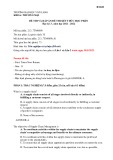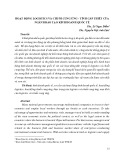
Int. J Sup. Chain. Mgt Vol. 8, No. 6, December 2019
752
The Impact of Foreign Investment on Balance
of Payments Based on the Supply Chain
Management: An Econometrics Study for the
Period of 2005-2017 in Iraq
Alaa Abbas Dakhil1, Dr.Maiami Salal Sahib Al-shukri2 , Dr.Mayih Shabeeb Al-Shammari3
1,2 Department of Economics, college of Management and Economics, University of Al Qadisiyah ,Iraq
3 Department of Economics, college of Management and Economics, University of Kufa, Iraq
1Alaa.dakhil@qu.edu.iq
2Maiami.Alshukri@qu.edu.iq
3Mayih.Shabib@Uokufa.edu.iq
Abstract- This examination explores the effect of foreign
direct investment on the supply chain management and
balance of payment in Iraq market. The study is
conducted in Iraqi circumstances focusing on the time
period of 2005-2017 by considering the supply chain
management. Johansen-Juselius co integration
technique has been employed to measure the association
among variables of interest which is FDI, CAB and
GDP. In this context of particular importance are
management concepts such as supply chain and chain
quality management concepts. Therefore, our aim is to
analyze the influence of Foreign Direct Investment
(FDI) on the Iraq business. Furthermore, VECM
estimation is carried out to determine a long and short
run influence of FDI on current account balance. The
results revealed that foreign investment is co-integrated
with balance of payment. Furthermore, a positive
impact of FDI has been recorded on CAB (current
account balance). The results infer export led policy can
positively affects the balance of payment with the
foreign inflows. Therefore, as a policy implication, FDI
should be taken into account when policy makers are
making policies regarding economic development.
Keywords- supply chain management, economic
development, Foreign Investment, Balance of Payments.
1. Introduction
In this persistently evolving arena, the importance of
foreign direct investment is essential for the growth
and development of economy. Foreign direct
investment can lead and impact the economic factors
for instance unemployment reduction, production
pattern, technological advancement and import and
export level. The flow of foreign direct investment
can influence and improve essentially and
extensively the dimension of yield and the exchange
of a nation and can likewise quicken and accelerate
its development and advancement. Further, it plays
an imperative and central job in accomplishing the
nation's social and financial goals and targets.
Further, underdeveloped country can benefit the
positive impacts of foreign direct investment in terms
of economic prosperity, infrastructure development,
technology transfer, and innovation, advancing and
upgrading its exchange with the world [1]. As a
result, the term supply chains is rapidly becoming the
new norm in discussing the spread of trade and
investment around the globe.
The FDI with its huge, obvious and considerable
effect on the volume of exchange likewise renders
help to coordinate the household economy with the
worldwide economy. FDI is involving a long-term
capital investment reflecting a lasting interest and
control by a resident entity. FDI inflows are
accounted under the balance of payment capital
record. Initially a positive influence of foreign direct
investment on balance of payment has recorded.
However, an indirect impact on the balance of
payment has also witnessed for example current
account of balance of payment due to noteworthy
effect on the volume of import and export. In this
manner the foreign direct investment has an
important role in the balance of payment accounts.
Balance of Payments also known as BOP comprises
of current, capital and settlement accounts. The one
year record of economic transactions of a country
about financial exchanges with the world is
attenuated as balance of payment. Foreign direct
investment effect of on the BOP is still in debate and
has inconclusive evidence. It relies on the two inverse
inclinations where FDI inflow stimulates the imports
______________________________________________________________
International Journal of Supply Chain Management
IJSCM, ISSN: 2050-7399 (Online), 2051-3771 (Print)
Copyright © ExcelingTech Pub, UK (http://excelingtech.co.uk/)

Int. J Sup. Chain. Mgt Vol. 8, No. 6, December 2019
753
of host nation on the grounds that the FDI
organizations import capital and middle products that
are not promptly accessible in the host nation.
Foreign direct investment influences the GDP growth
on one hand due to capital investment and also
stimulates the imports on the other hand. Hence, it is
important to discuss the association among these
economic indicators. Therefore, this study is aimed at
investigating the role of foreign direct investment on
balance of payment. FDI influence the Balance of
Payments is more significant in least developed
economies. This influence is separated from FDI
benefits, for example, lower costs, higher efficiency,
better quality, and so forth. The conspicuous result of
such recognition has been which were taken to be
proverbial. The undeniable result of such an
observation has been continued weighted by the
international Organization for Economic support such
as OECD to effectively manage balance of payment
and thrust FDI as a necessary ingredient of economy.
FDI has got the central position in the balance of
payment management strategy. Therefore, FDI
Inflows are considered as directional methodology
towards accomplishing monetary development [2].
Various investigations have been led to evaluate
relationship of foreign direct inflows with GDP
development, local investment, poverty, economic
imbalance and other macroeconomic factors.
However, past literature has a lack of arguments to
discuss the effect of foreign direct investment on
balance of payment. To fill the gap in existing
writing for Iraq, this examination aimed to explore
the effect of foreign direct investment on current
account balance and GDP of Iraq for the period 2003-
2016 by utilizing ARDL estimation technique.
2. Literature Review
Foreign direct investment offers rich opportunities
for emerging economies to attract middle- and
higher-skill operations and to link into multinational
corporate global supply chains. The focus on FDI has
got attention in the era of 70’s when many
developing countries were focusing on local
industrialization which affects the balance of
payment in negative way. In the meantime expanding
FDI in the East Asian countries start of an
unavoidable and significant pattern in the
development of investment and trade inverted the
situation [3]. It is found that in least develop
countries FDI increases the productivity and
positively impact the balance of payment [4]. In
addition, the volume of foreign direct investment was
the most important of the host country's remuneration
and was becoming increasingly significant in under
developed countries. This suggests that any
arrangement of managing the exchange rate on
exports and imports would be a way of to drive
economic development [5]. Hence, countries seeking
to come up with a development agenda could derive
more prominent benefits from the flow of foreign
direct investment. The reality proposes that per capita
pay in the host nation has the main impact. In the line
of these studies [6] found regardless of whether the
FDI swarms out a portion of the domestic enterprises,
it may encourage the host economy to extend its
manufacture, by utilizing wide range advancements.
Countries with a higher per capita gross domestic
product (GDP) share greater inflows of foreign direct
investment (FDI), has a propitious influence on the
balance of payments. It is also witnessed that
companies brought FDI had higher trends of exports
than domestic companies William Morse. [6] referred
to two purposes of FDI, namely, foreign direct
investment in the search for markets and the search
for efficient foreign direct investment. The former
may accelerate imports while leading to an increase
in exports. The impact of the balance of payments on
FDI is vague and indecisive in terms of the purpose
of foreign direct investment. Manufacturing exports
of multinational companies in least developed
countries in 70’s was very low as compare to post
70’s era [7]. Furthermore, deficiencies in BOP are
generally associated with the debt payment problems
and committed investment [8]. A study of emerging
markets reveled that imports, exports and economic
growth are the most influential indicators those have
a significant impact over balance of payment [9; 10].
It was reported that the operation of multinational
companies reduced the cost of exporting which
benefit the domestic enterprises. It refers to factors
relevant to the host country, which manipulate the
size and nature of the transactions of foreign
linkages, including the stage of development,
technical capacity, production size and resources
[11]. The United Nations reviewed these effects of
foreign direct investment (FDI) on the balance of
payments of East Asian countries and found parallel
results to [11]. The impact of foreign direct
investment (FDI) exchange and its impact on the

Int. J Sup. Chain. Mgt Vol. 8, No. 6, December 2019
754
current balance of payments record are associated
with term of trade. Although at the beginning, due to
the transfer of capital to the host country the change
is smaller, it may disturb in due course of time when
interest and dividends begin to expatriate. Another
effect is determined as the inflationary impact on FDI
as a result of the expansion of commerce,
consumption and livelihoods. It was found that it was
important to analyze the balance of payments when
BOP was particularly characterized by the impact of
foreign direct investment. Capital inflows to the
country have different effects on balance-of-
payments accounts and have an extreme impact on
the balance of payments equation [12]. This may be
more fragile and low if the total amount of the project
is fixed in one country and foreign direct investment
needs to replace local venture. After a positive link
has been established with the current account of the
balance of payments, foreign direct investment may
encourage transformational exports. Foreign direct
investment transfers resources from home countries
to host countries by transforming management skills
and opportunities for skilled workers to learn new
production technologies. Foreign direct investment
has an indirect impact and a source of technology
transfer. It is also asserted that foreign direct
investment inflows gave the impression that FDI
inflows posed a threat to the development of under
developed economies [13]. Foreign direct investment
in long-term capital has led to the payment of capital
in dire budget emergencies. Therefore, foreign direct
investment could lead to the pain of ending domestic
resources and prove unsafe for the economy. The
benefits gained through capital investment returned
to countries at the beginning of this distant project,
which has had a terrible impact on the current
account balance. The increase in foreign direct
investment inflows had led to a further lack of current
account balance as foreign direct investment had
pushed domestic participants into bankruptcy. This
situation benefits the foreign firm to expanded
imports and lower level of efficiency [14]. Conversly,
the impact of foreign direct investment on
development is significant in case in the context of
export progress in developing economies [5]. Few
studies have been accounted for in the writing
breaking down the effect of FDI on current account
balance. This investigation endeavors to make an
experimental examination of the effect of FDI on
Iraq's current account balance. The examination
could enable policymakers to create financial
approaches that are in line with the nation's financial
conditions to draw in FDI.
3. Methodology
The study used time series data from World Bank
data sources during the 2005-2016 period. The
variables selected for the model are foreign direct
investment, current account balances and real gross
domestic product (GDP). The following equation is
used to explain the basic econometric equation.
LnCAB = ƒ(LnFDI, LnGDP) (1)
In the above equation natural log of current account
balance is used as dependent variable while natural
log of FDI and GDP are used as independent model.
This model expects a positive change in current
account balance due to capital inflows and GDP. This
induces that an increase in foreign investment
increases the local production and increase the
exports of country. As an export oriented country,
FDI inflows in Iraq will bring positive changes in
BOP and particularly current account balance.
Although [15] argued that capital inflows increases
imports due to change in consumption pattern
however this study follow the [5] argument that
export led countries can get positive changes in
balance of payment due to foreign inflows.
To avoid pseudo-relationships, we use Augmented
Dickey and Fuller (ADF) test to analyze the
stationarity in the variable of interest by supply chain
strategy. The ADF test is follow by regression
estimates In order to show the long-term relationship
between variables. For this purpose Johansen and
Juselius estimation are used to simulate the
relationship between integrated variables. Further we
employed VECM to evaluate the short-term
characteristics of co-integrated variables. The VECM
equation for the proposed model is presented below:
𝐶𝐶𝐶𝐶𝐶𝐶𝑡𝑡=𝛼𝛼0+γ1𝐸𝐸𝐶𝐶𝐸𝐸 +
∑β1FDIk−1 +
𝑛𝑛
𝑘𝑘=0 ∑β1GDP
k−1
𝑛𝑛
𝑘𝑘=0 (2)
3.1. Empirical Results
The tendency of supply chain development programs
to be captured by small-business lobbies, and the
willingness of international donors to tolerate, even
promote this, has adverse consequences for emerging
economies. The ADF test results are presented I table

Int. J Sup. Chain. Mgt Vol. 8, No. 6, December 2019
755
1. The results shows that all the variables are non-
stationary at level and stationary at I(1).
Table1. ADF Estimation
Variables
ADF test
I(0)
I(1)
LnCAB
-2.152
-3.634**
LnFDI
-2.825
-3.833**
LnGDP
-2.264
-5.724*
*, ** and *** denote significance level at 1%, 5%
and 10%, respectively. ADF tests include intercept
and trend.
Further, to apply Johansen co-integration test the
length of lag has determined through AIC test. On the
basis of AIC (Akaike information criteria) the
maximum lag length of 2 lags is estimated. Further,
Johansen co-integration test is applied and results are
presented at table 2 and 3.
Table2. Co-Integration Rank Test-Trace Value
No of CEs
Eigen value
Trace statistics
5% critical value
Prob**
None*
0.782630
92.77343
36.2668
0.00
At most 1*
0.681892
47.81243
23.9667
0.023
At most 2*
0.169023
8.912462
17.1315
0.011
Table3. Co-Integration Rank Test-Maximum Eigen Value
No of CEs
Eigen value
Trace statistics
5% critical value
Prob**
None*
0.782630
56.823712
25.18252
0.00
At most 1*
0.681892
36.13256
20.32677
0.001
At most 2*
0.169023
5.824222
13.82314
0.034
Figure1. Time Series of CAB and FDI
Since the results indicated the co-integration among
the series, the Johansen test has confirm a long run
relationship among foreign direct investment and
balance of payment. The outcomes in Table (2) and
(3) demonstrate that FDI and CAB have long run
association. The Eigen estimations and trace statistics
values are greater than critical values. Hence, there
exists a stable long run connection among FDI and
current account balance. Further vector error
correction model is employed to determine the
equilibrium of long run relationship. The results for
VECM are presented in table (4).

Int. J Sup. Chain. Mgt Vol. 8, No. 6, December 2019
756
Table 4.Vector Error Correction Model Estimation in SCS
Independent Variable= CAB
Variables
Coefficient
t-value
Prob**
Constant
278151.7***
4.28363
0.000
LnCAB(-1)
0.18634***
3.99176
0.000
LnCAB(-2)
0.12846
4.26122
0.179
LnFDI(-1)
803862.25***
6.92375
0.000
LnFDI(-2)
317835.11
3.87778
0.000
LnGDP(-1)
642835.76***
9.98234
0.000
LnGDP(-2)
729437.54***
7.35715
0.000
ECMt-1
0.52721***
11.5562
0.000
R2
0.718
Adjusted R2
0.683
F-statistics
45.12634
Jarque-Bera Chi2
5.820374
Breusch-Godfrey LM
0.046223
Hetroskedasticity test
0.058236
*** Represent the level of significance at 1%.
VECM estimation uncovers long-run balance
relationship which has been recorded by the
evaluated parameter (γ ) of the term (ECMt−1). Te
value of ECMt−1 is positive as expected in the
theoretical model based on the work of [5]. The
outcomes show that FDI inflows identified as a
positive instrument to balance the current account
and balance of payment. The estimation of
coefficient of ECM is (0. 52721) infers that error
correction process merges to balance with the
modification speed of 52.72% from current to next
timeframe. The model diagnostic tests named as
Jarque-Bera Chi2, Normality test, Breusch-Godfrey
LM test, ARCH LM test and Hetroskedasticity tests
are incorporated. The measurements detailed above
in table (3) are demonstrating that the residuals are
ordinarily distributed having no sequential
relationship and ARCH impacts.
4. Conclusion
International retailers, trying to bring their
established supplier relationships with them to Iraq,
are forced to start working with local suppliers due to
the existing tax and customs regulations in Iraq,
which complicate the import of goods by foreign
companies. Therefore, the international retailers are
forced to use locally produced resources and goods
which needs supply chain strategy to improve its
fluency and adaption. The study endeavors to
investigate the conceivable heading of causality and
long run balance connection between FDI, GDP and
CAB of Iraq over the period of 2005-2017 by
applying a VECM estimation technique under the
supply chain strategy. Augmented Dicker and Fully
test results demonstrate all the variables are
stationary at 1st difference. Further, co-integration
test results demonstrate a long run connection
between foreign investment and balance of payment
where current account balance (CAB) is considered
as a proxy of BOP. The error correction model is then
carried out to investigate the long run equilibrium
among FDI and BOP. Vector Error Correction
Model estimation exhibit FDI impacts BOP both in
short-run and long-run for the investigation time
frame. The positive parameter of the mistake remedy
term affirmed that a long-run harmony relationship
existed among the factors. Furthermore, the
motivation reaction work uncovered a positive
impact of FDI and SCC for Iraq in the selected time
frame.
References
[1] UNCTAD-DTCI. Transnational Corporations
as Engines of Growth. World Investment Report
1995. Geneva: United Nations, 1992.



![Đề thi Quản trị Logistics và chuỗi cung ứng quốc tế học kì 2 năm 2024-2025 có đáp án [Mới nhất]](https://cdn.tailieu.vn/images/document/thumbnail/2025/20250915/kimphuong1001/135x160/59591757927414.jpg)













![Đề kiểm tra Quản trị logistics [mới nhất]](https://cdn.tailieu.vn/images/document/thumbnail/2025/20251015/2221002303@sv.ufm.edu.vn/135x160/35151760580355.jpg)
![Bộ câu hỏi thi vấn đáp Quản trị Logistics [năm hiện tại]](https://cdn.tailieu.vn/images/document/thumbnail/2025/20251014/baopn2005@gmail.com/135x160/40361760495274.jpg)







